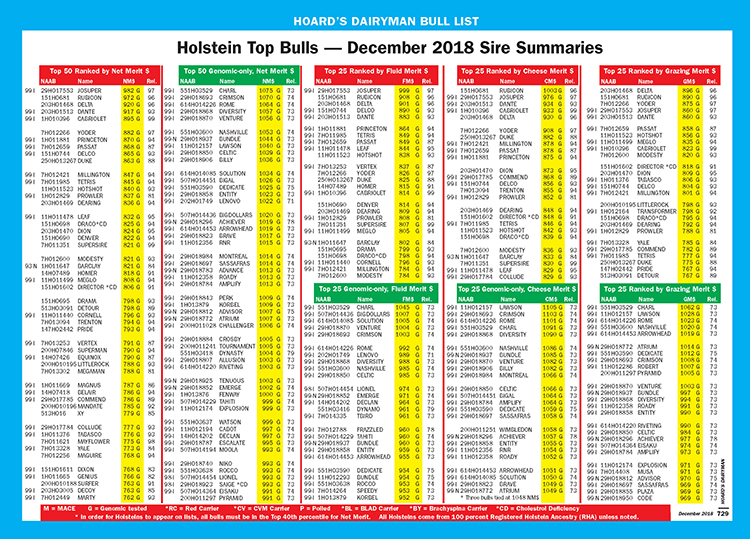While the Hoard’s Dairyman Bull List will be available in the December issue, we are making it available to readers now. It can be downloaded by clicking this link.
To make heads or tails of all those bulls, we sorted through the top bulls and ranked them on nine different traits or indexes in the Holstein breed. In Jerseys, we ranked bulls on two traits; and all other breeds on one trait.
Young bulls fall slightly
In the Holstein and Jersey breeds, there was a slight recalibration of young bulls. The primary reason for the change was the introduction of the new DNA reference map (Genome Assembly), which includes a larger number of SNPs (single nucleotide polymorphisms) in the evaluation. Ultimately, the Genome Assembly looked at more DNA for the December genetic evaluations . . . 80,000 SNPs versus 60,000 SNPs. This impacted fat and protein evaluations the most.
What does this all mean in the rankings?
There was a slight drop in fat and protein . . . and of course Net Merit (NM$). For example, bulls born in 2018 dropped by 2.9 pounds of PTA (predicted transmitting ability) Fat and 1.2 pounds PTA Protein. That caused Holstein bulls born in 2018 to drop by $21 NM$.
The impact on the Jersey breed was quite similar. However, Jersey bulls with less breed purity were affected at an even greater level. Those bulls would be coded with the number of generations from purebred Jersey lineage . . . GC2, GC3, GC4, GC5, and GC6 on the Hoard’s Dairyman Bull List. Those with a lower number have less breed purity.
Young Brown Swiss bulls also experienced a slight downward trend for fat and protein because of a deeper look into DNA test results.
New haplotype affects fertility
The December 2018 Council of Dairy Cattle Breeding (CDCB) evaluations will feature a new recessive haplotype listing in Holsteins.
The haplotype, HH6, was discovered in France and impacts fertility. According to CDCB data, carrier sires and maternal grandsires with the recessive haplotype had an average 9 percent lower conception rate. Frequency in U.S. data is only 0.5 percent.
Additionally, the haplotype BH1 will be removed from the Brown Swiss reporting. Its fertility effect was no longer significant.
The Jersey haplotype, JH2, will also be dropped in the December reports. “As causative mutations were not found for either BH1 or JH2, both haplotypes will no longer be reported,” the CDCB announcement concluded.
Young bulls dominate
There were 4,390 bulls declared active by A.I. marketing organizations. That was up 225 bulls from August 2018. Overall, there were 1,125 bulls available that also have milking daughters. In a previous generation, these were called daughter-proven bulls.
A.I. studs once again added more genomic offerings . . . a record 3,265 bulls were available this December compared to 3,058 in August 2018. That’s 207 additional genomic bulls declared for sale to farmers.
A new record
When everything is considered, genomics garner the largest portion of the bull rankings. The ratio of genomic bulls declared active climbed to 74.4 percent — that’s a new watermark. That tops the previous record from August 2018 evaluations . . . a pinnacle of 73.4 percent.









